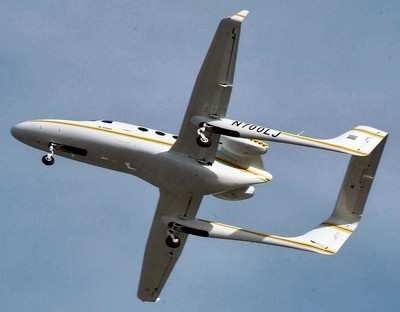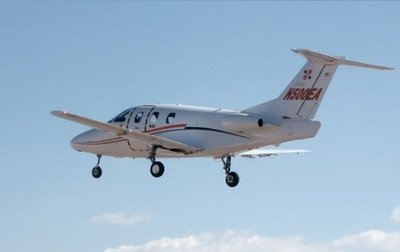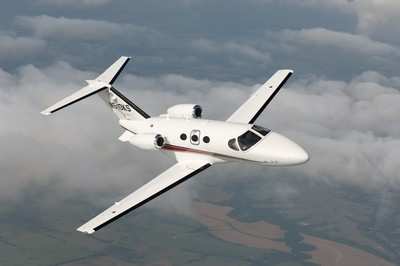Says Slower Jets Could 'Gum Up' System
GAMA leadership and FAA representatives appeared before congress
on Thursday to discuss the impact very light jets (VLJ) will have
on the national airspace system -- not very much, according to
them. Meanwhile, members of the Airline Transport Association (ATA)
told Bloomberg Thursday they would have a "significant"
impact.

Eclipse Aviation, maker of the Eclipse 500 VLJ, has orders for
2600 aircraft. Adam Aircraft boasts 350 orders for its A700. Cessna
says 250 customers are waiting for their Mustang Jets. If even a
fraction of these orders are realized over the next few years, ATA
says, it will mean many more aircraft operating in the
airspace normally used only be commercial jetliners today.
"Even 1,000 more vehicles in the system would be a significant
new burden," said ATA executive vice president John Meenan. He
further opined that VLJ's will operate at the same altitudes
as jetliners, but at significantly slower speeds --
creating "the potential for really gumming up the system."

This is in direct opposition to FAA statements made before
congress on Thursday. As Aero-News reported,
Nicholas Sabatini, Associate Administrator for Aviation Safety, and
Michael Cirillo, Vice President of Systems Operation Services
within the FAA's Air Traffic Organization, told a congressional
committee that the FAA has the capability to safely introduce all
aircraft into the system, no matter the size, speed or
performance.
"VLJs will be assimilated into the system in an orderly
fashion," said Sabatini. Cirillo added, "Major airports will not be
inundated with VLJs."
So who's right... will VLJs impact ATC or not?
The answer is, they probably will have SOME impact. The real
question? Will it be enough to wreak the havoc ATA predicts?
There most certainly will be some growing pains as the number of
users in the airspace increases, but as was pointed out to congress
on Thursday, most VLJs won't be using the same airports as
commercial transport aircraft.

GAMA says controller workload is directly related to the number
of planes in a particular area. The greatest congestion is around
the 30 so-called hub airports where major airlines base their
headquarters and maintenance facilities. Trying to get large
numbers of aircraft into and out of a hub airport places them all
in a relatively small portion of the sky. This complicates a
controller's job immensely.
That's not a problem with VLJs. Operating from shorter runways
such as those found at secondary and outlying airports will allow
the VLJ owner to takeoff and land closer to their homes and
destinations -- instead of connecting through the hub of a major
airline.
 Still, VLJs will have to
traverse airspace used by jetliners to get to some secondary
airports located near particularly congested airspace such as New
Jersey's Teterboro and New York's White Plains. For that reason,
says former FAA director of system operations Jack Kies, the FAA
should study traffic flows with input from potential VLJ users to
better understand exactly where the aircraft will be going.
Still, VLJs will have to
traverse airspace used by jetliners to get to some secondary
airports located near particularly congested airspace such as New
Jersey's Teterboro and New York's White Plains. For that reason,
says former FAA director of system operations Jack Kies, the FAA
should study traffic flows with input from potential VLJ users to
better understand exactly where the aircraft will be going.
Kies, now an executive with Metron Aviation in Virginia, says
"There is going to be an impact to the system. It will be a
challenge for everybody."
GAMA leaders predict adding about 300 VLJs per year to the
system. They say that even if VLJs have the "significant"
impact ATA predicts, FAA modernization efforts now under way
should more than make up for any ATC shortcomings.
Embry-Riddle aeronautical science department chairman Cass
Howell feels even 300 VLJs per year might be high,
notwithstanding FAA's estimate of 4000 over the next
decade. He said, "The history of aviation is replete with
people who had a great idea that never got through. Slowdowns in
certification, manufacturing and financing are all possible."
Whatever happens, with two big names like Cessna and Eclipse
having already achieved FAA certification, VLJs are here to stay.
As their utility becomes more obvious to frequent business flyers
tired of lost luggage, unnecessary overnight stays and odious lines
to get through security, they are sure to proliferate.
Then everybody, including the ATA, is going to have to learn how
to work and play together.
 ANN's Daily Aero-Term (04.20.24): Light Gun
ANN's Daily Aero-Term (04.20.24): Light Gun Aero-News: Quote of the Day (04.20.24)
Aero-News: Quote of the Day (04.20.24) ANN's Daily Aero-Linx (04.21.24)
ANN's Daily Aero-Linx (04.21.24) Aero-News: Quote of the Day (04.21.24)
Aero-News: Quote of the Day (04.21.24) ANN's Daily Aero-Term (04.21.24): Aircraft Conflict
ANN's Daily Aero-Term (04.21.24): Aircraft Conflict






